- genevb's home page
- Posts
- 2025
- 2024
- 2023
- 2022
- September (1)
- 2021
- 2020
- 2019
- December (1)
- October (4)
- September (2)
- August (6)
- July (1)
- June (2)
- May (4)
- April (2)
- March (3)
- February (3)
- 2018
- 2017
- December (1)
- October (3)
- September (1)
- August (1)
- July (2)
- June (2)
- April (2)
- March (2)
- February (1)
- 2016
- November (2)
- September (1)
- August (2)
- July (1)
- June (2)
- May (2)
- April (1)
- March (5)
- February (2)
- January (1)
- 2015
- December (1)
- October (1)
- September (2)
- June (1)
- May (2)
- April (2)
- March (3)
- February (1)
- January (3)
- 2014
- December (2)
- October (2)
- September (2)
- August (3)
- July (2)
- June (2)
- May (2)
- April (9)
- March (2)
- February (2)
- January (1)
- 2013
- December (5)
- October (3)
- September (3)
- August (1)
- July (1)
- May (4)
- April (4)
- March (7)
- February (1)
- January (2)
- 2012
- December (2)
- November (6)
- October (2)
- September (3)
- August (7)
- July (2)
- June (1)
- May (3)
- April (1)
- March (2)
- February (1)
- 2011
- November (1)
- October (1)
- September (4)
- August (2)
- July (4)
- June (3)
- May (4)
- April (9)
- March (5)
- February (6)
- January (3)
- 2010
- December (3)
- November (6)
- October (3)
- September (1)
- August (5)
- July (1)
- June (4)
- May (1)
- April (2)
- March (2)
- February (4)
- January (2)
- 2009
- November (1)
- October (2)
- September (6)
- August (4)
- July (4)
- June (3)
- May (5)
- April (5)
- March (3)
- February (1)
- 2008
- 2005
- October (1)
- My blog
- Post new blog entry
- All blogs
RT Ticket 2378
For RT Ticket 2378 (with some details presented at this week's S&C meeting), I will try to provide more specific and quantitative details on the impacts for embedding reconstruction here. I have organized this page in 3 sections:
I record here further information on runs and events affected by anode voltages being within 110 V of nominal, but just below the cut-off for the dE/dx corrections. I now restrict to time periods during good status production runs. However, given that the gains perhaps do not fall off quite as fast as originally expected in the TPC, it may be worth re-doing this allowing for more than 110 V drop.
_______________________
Run 10
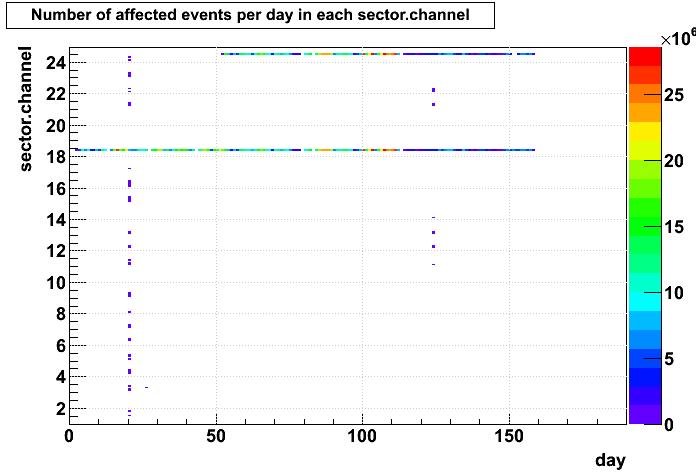
The two big problems were channel 24-5 and 18-4 spanning large ranges of days. In sector 24, the outage from the anodes is right next to a dead RDO, making the problem notably worse since the tracker struggles to connect that far. Otherwise, there are just a few other problems:
_______________________
Run 11
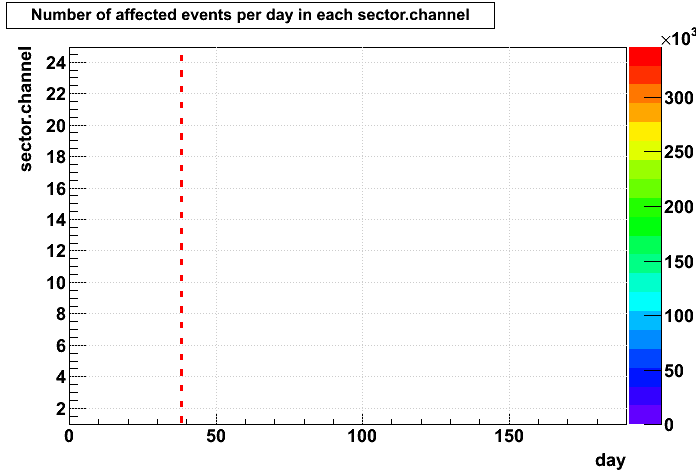
There are a couple other places with voltage down by more than 110 V (some at 140V, for example, could be worth worrying about but I'm not sure), otherwise it's just a few runs on day 38 which comprise the red line in the plot:
Run 12
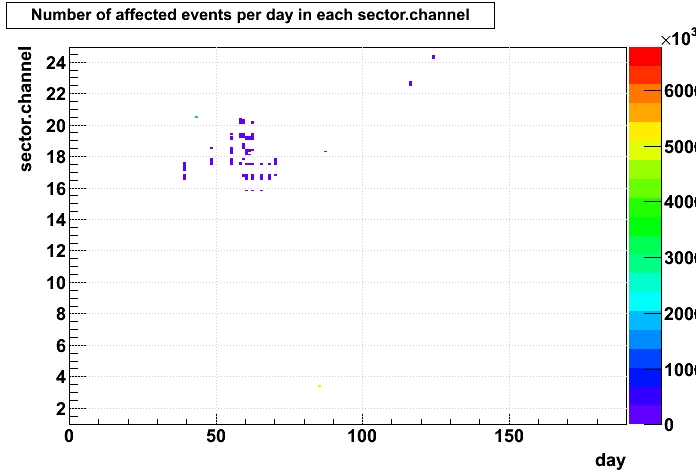
There are numerous scattered mildly affected event counts in various channels (generally on the east side, and mostly towards the end of the pp200 operations) which are too many to simply list. More signficant issues occurred thrice, each of which are rather small dots on the above plot because they are single channels that were only problematic for a brief time period:
_________________________________________
In order to help understand the impact, it is likely useful to learn where anode channels are with respect to padrows in a TPC sector (as a side note, generally there are two anode "sockets" per "channel"). The anode wires sit a few millimeters away from the readout pads, and there are multiple anode wires which influence any given padrow. Sometimes a padrow may even be influenced by more than one channel of anode wires, such as padrows 21, 29, and 37.
I show here some plots from Offline QA of counts of hits in TPC sectors. The density of hits falls off with increasing distance from the collision vertex as the tracks spread out, so an ideal plot will be red at padrow 1, green at padrow 45, and have some blue fringes along the ends of the padrows. Anode channels are denoted by red numeration on the left of the plot, and each spans the same distance in radius. Since padrows on inner sectors are sparse, less padrows are influenced by any given inner anode channel than for outer sectors (~3 padrows vs. ~8). Thus, tracks will likely lose ~3 or ~8 hits just from an inner (1-4) or outer (5-8) channel being dropped. However, as noted before, if that channel kills padrows next to some other dead TPC element (such as a dead RDO or some other anode channel), there is a good chance of stopping the tracks there, so that even unaffected innermost padrows may be left off tracks.
The first plot shows anode channel 24-5 with voltage reduced by 45 V. One can see the density in that channel is actually slightly less than the next channel out in radius. Also visitble on that plot is a dead RDO channel 24-2, in which absolutely no hits are reconstructed (RDO channels are denoted by black numeration on the right and lines drawn on the sectors). This is the example for which padrows 1-8 may not have any issues, but could still be left off tracks if the tracker sees nothing in padrows 9-20.
The second plot shows anode channel 7-6 with voltage reduced by 140 V. Even with such low voltage, there are hits which are available to be used in tracking. Unless the originator of the charge was a highly ionizing particle (such as a low momentum proton), the collected charge of these hits will be very small (this can be seen by looking at the ADC-weighted distributions in the Online QA; see run 11071062 for this example), so their quality is rather poor. It may be that their contribution to the track fit is negligible.
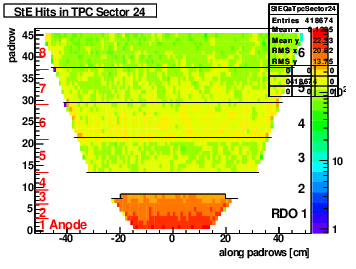
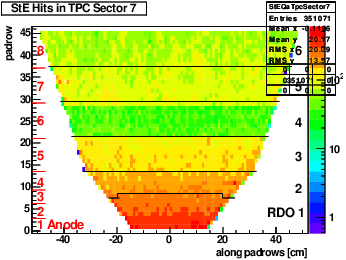
_________________________________________
This is difficult to ascertain with actually running the reconstruction and studying the impacts of track properties that matter in any given analysis. Kolja's embedding QA plots demonstrated a 25-30% degradation of <DCA> when anode channel 24-5 was lost, but this scenario is worse than most because tracking essentially lost the otherwise-OK innermost padrows too. It would be logical to say that the degration of any random anode channel on track quality would be between 0% and this 25-30%. Perhaps 10-20% degradation on quality metrics for tracks passing through a single problem channel is a reasonable estimate, and again seeing more degradation if the problem channel is next to another dead TPC element.
It is worth keeping in mind that the hits in question were not assigned dE/dx in either standard reconstruction or the embedding, so there should be no impact to track dE/dx measurements unless they are somehow conjoined with some other impacted quantity, e.g. number of dE/dx hits divided by number of total hits on a track is greater than some cut value.
_____________________
-Gene
- Which anode channels are affected and when?
- What is the impact on TPC hits?
- What is the impact on track quality?
Section 1: Which anode channels are affected and when?
I record here further information on runs and events affected by anode voltages being within 110 V of nominal, but just below the cut-off for the dE/dx corrections. I now restrict to time periods during good status production runs. However, given that the gains perhaps do not fall off quite as fast as originally expected in the TPC, it may be worth re-doing this allowing for more than 110 V drop.
_______________________
Run 10

The two big problems were channel 24-5 and 18-4 spanning large ranges of days. In sector 24, the outage from the anodes is right next to a dead RDO, making the problem notably worse since the tracker struggles to connect that far. Otherwise, there are just a few other problems:
- Essentially all runs dropped channel 18-4 (1518.2M events)
- Essentially all runs after and including run 11052058 dropped channel 24-5 (914.8M events)
- AuAu200 runs 11020075-77 dropped many inner sectors (0.6M events)
- AuAu200 runs 11026041-42 dropped channel 3-3 (0.5M events)
- AuAu7 runs 11124044-46 dropped a few inner sectors (0.2M events)
_______________________
Run 11

There are a couple other places with voltage down by more than 110 V (some at 140V, for example, could be worth worrying about but I'm not sure), otherwise it's just a few runs on day 38 which comprise the red line in the plot:
- pp500 runs 12038110-114 dropped all inner sectors (0.35M events)
Run 12

There are numerous scattered mildly affected event counts in various channels (generally on the east side, and mostly towards the end of the pp200 operations) which are too many to simply list. More signficant issues occurred thrice, each of which are rather small dots on the above plot because they are single channels that were only problematic for a brief time period:
- pp200 runs 13043034-35 dropped channel 20-5 (2M events)
- pp500 runs 13085029-32 dropped channel 3-4 (5.2M events)
- pp500 runs 13087014-38 dropped channel 18-3 (6.8M events)
_________________________________________
Section 2: What is the impact on TPC hits?
In order to help understand the impact, it is likely useful to learn where anode channels are with respect to padrows in a TPC sector (as a side note, generally there are two anode "sockets" per "channel"). The anode wires sit a few millimeters away from the readout pads, and there are multiple anode wires which influence any given padrow. Sometimes a padrow may even be influenced by more than one channel of anode wires, such as padrows 21, 29, and 37.
I show here some plots from Offline QA of counts of hits in TPC sectors. The density of hits falls off with increasing distance from the collision vertex as the tracks spread out, so an ideal plot will be red at padrow 1, green at padrow 45, and have some blue fringes along the ends of the padrows. Anode channels are denoted by red numeration on the left of the plot, and each spans the same distance in radius. Since padrows on inner sectors are sparse, less padrows are influenced by any given inner anode channel than for outer sectors (~3 padrows vs. ~8). Thus, tracks will likely lose ~3 or ~8 hits just from an inner (1-4) or outer (5-8) channel being dropped. However, as noted before, if that channel kills padrows next to some other dead TPC element (such as a dead RDO or some other anode channel), there is a good chance of stopping the tracks there, so that even unaffected innermost padrows may be left off tracks.
The first plot shows anode channel 24-5 with voltage reduced by 45 V. One can see the density in that channel is actually slightly less than the next channel out in radius. Also visitble on that plot is a dead RDO channel 24-2, in which absolutely no hits are reconstructed (RDO channels are denoted by black numeration on the right and lines drawn on the sectors). This is the example for which padrows 1-8 may not have any issues, but could still be left off tracks if the tracker sees nothing in padrows 9-20.
The second plot shows anode channel 7-6 with voltage reduced by 140 V. Even with such low voltage, there are hits which are available to be used in tracking. Unless the originator of the charge was a highly ionizing particle (such as a low momentum proton), the collected charge of these hits will be very small (this can be seen by looking at the ADC-weighted distributions in the Online QA; see run 11071062 for this example), so their quality is rather poor. It may be that their contribution to the track fit is negligible.


_________________________________________
Section 3: What is the impact on track quality?
This is difficult to ascertain with actually running the reconstruction and studying the impacts of track properties that matter in any given analysis. Kolja's embedding QA plots demonstrated a 25-30% degradation of <DCA> when anode channel 24-5 was lost, but this scenario is worse than most because tracking essentially lost the otherwise-OK innermost padrows too. It would be logical to say that the degration of any random anode channel on track quality would be between 0% and this 25-30%. Perhaps 10-20% degradation on quality metrics for tracks passing through a single problem channel is a reasonable estimate, and again seeing more degradation if the problem channel is next to another dead TPC element.
It is worth keeping in mind that the hits in question were not assigned dE/dx in either standard reconstruction or the embedding, so there should be no impact to track dE/dx measurements unless they are somehow conjoined with some other impacted quantity, e.g. number of dE/dx hits divided by number of total hits on a track is greater than some cut value.
_____________________
-Gene
Groups:
- genevb's blog
- Login or register to post comments
